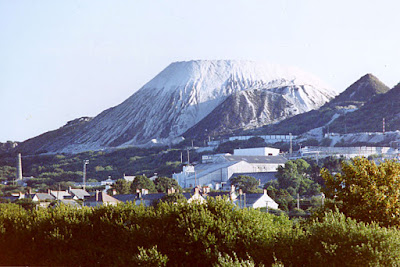The St. Austell region is Cornwall's China Clay district, the area being dominated by the impressive sharp peaks of mine waste, known locally as the "Cornish Alps". China Clay, or kaolin, is decomposed granite and was first used in China over 10,000 years ago to make fine white porcelain.
By the early 19th century the St. Austell deposits were the largest in the world and many other uses had been found for the clay, such as in paper, paint and rubber goods. By 1910 Cornwall produced around half of the world's china clay and in 1919 the three main producers merged as English China Clay, which was bought by the French company Imerys in 1999. The company moved most of its operations to Brazil in the early part of this century and there are now fewer than 2000 employees left in Cornwall.
The legacy of China Clay still defines this region, however, with one of Cornwall's major tourist attractions, the Eden Project, sitting in a former china clay pit.
The Eden Project is only a 30 mile drive from Falmouth, and well worth a visit to its two iconic biomes, but if you would also like to take in a beautiful 4 mile woodland walk, with the added bonus of seeing some 19th century mine ruins, then include the Luxulyan Valley on your day out, as it is only a couple of miles from the Eden Project.
The River Par rises near Roche and flows through the China Clay areas around Bugle before descending through the Luxulyan Valley then on to the sea at Par.
 |
| The River Par flowing through the Luxulyan Valley |
The Luxulyan Valley has a network of walking trails mostly on the routes of 19th century horse-drawn tramways. The tranquil walks through the valley are made the more interesting by the 19th century ruins which led to the area being designated a Cornish Mining World Heritage Site. Most of the structures in the Valley are the result of the imagination and enterprise of Joseph Treffry. Between the 1820s and his death in 1850 Treffry's buildings, tramways and leats transformed the valley into an area of intense industrial activity, associated with granite quarrying, copper and tin mining and china clay and stone production.
 |
| 19th century tramway |
The most impressive structure is the Treffry Viaduct, constructed between 1839 and 1842 from local granite to carry the tramway 27 metres above the valley floor. The first stone viaduct built in Cornwall, it consists of 10 arches spanning 200 metres, and also doubled as an aquaduct, the water channel beneath the railway track sloped to create a steady flow of water, extracted upstream from the River Par, to feed Carmears leat.
 |
| Treffry Viaduct |
Carmears leat is the upper leat in the valley, and was constructed to supply water to a huge wheelpit, which was brought into service in 1842. The original waterwheel was 30 ft in diameter and was used for hauling wagons up the inclined plane until the 1870s, when the tramway fell into disuse with the building of the Cornwall Minerals Railway. The wheel was then replaced with one of 40 ft diameter and was used until 1908 to drive grinding pans, which ground chunks of quarried partially decomposed granite, known as china stone, to yield a powder similar to china clay. China stone is granite which has partially decomposed, but not all the way to china clay. Porcelain is made by mixing china clay (kaolin) with ground china stone and melting them together in a kiln to form the ceramic. A patent was filed in 1768 for the manufacture of porcelain using entirely Cornish materials, previously this being only available from China.
 |
| Looking down at the wheelpit from Carmears leat |
 |
| The remains of the grinding pans |
 |
| By the China Clay driers, which operated from the 1920s to the 1960s |
If you would like to walk and picnic in the beautiful valley, I would suggest the 4 mile circular walk recommended by
iWalk Cornwall, which provides very clear directions.
 |
| A glimpse of the sea and the Par estuary from the tramway |
More Cornish Walks
























-EDIT.jpg)






I am glad to read on China Clay--a very important raw material for many uses. In India the clay is contaminated with iron, titanium etc and beneficiation on clay needs attention.
ReplyDeleteGood to read on old mining activities and heritage structures.
History has so many wonders--what tools and engineering softwares they had to create such structures ?Same in India/ and across the globe--huge temples/monuments with unbelievable architecture and beauty.